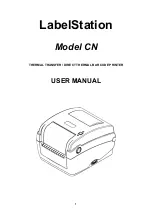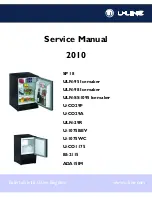
P34AL-15 & P34ALOF-15 Service Manual
SERVICING OPERATIONS
9/22/05
9-19
! WARNING !
It is not recommended that refrigerant to be transferred from a refrigeration system directly
into a cylinder. If such a transfer is made, the refrigerant cylinder must be an approved,
CLEAN cylinder--free of any contaminants or foreign materials--and must be weighed
continuously to assure contents do not exceed net weight specified by cylinder manufacturer of
any applicable code requirements.
! WARNING !
If ammonia vapor is released from the machine, it may be purged into water, which will absorb it.
Follow the purging instructions. See “Purging Non-Condensables”.
Note: Observe all local codes when handling and discharging anhydrous-ammonia refrigerant.
Refrigerant Leaks.
Anhydrous ammonia leaks can be detected by odor, sulfur stick, soap solution,
or test paper. The odor is normally noticed first and the location of the leak is found with soap or
sulfur stick. Soap solution can be purchased from your refrigeration supply house or it can be made
by mixing four parts water, one part liquid soap, and a few drops of Glycerin for better capillary
attraction.
•
Apply soap solutions with a narrow brush or spray bottle to all joints, welds, or areas of
suspicion. The solution will form bubbles if there is a leak.
Sulfur sticks and test paper can be obtained from your ammonia supplier.
•
Light the end of the sulfur stick and pass it around suspected points of leakage. A white cloud
will form where a leak is, even if it is very small.
•
Moisten a strip of test paper and pass it around the suspected area. If the paper comes in contact
with ammonia, it will turn red. Coils submerged in water, or condenser cooling water may be
tested by dipping a strip directly in the water. If ammonia is present, the paper will turn red.
Always remove refrigerant pressure from the vessel, tubing, or component part before repairs are
attempted.
Non-condensable Gasses.
Satisfactory operation of the machine is not possible if non-condensable
gases (usually air) are present in the system. Excessive condensing pressure is an indication of such
gases. Excessive condensing pressure in water-cooled condensers may also be due to the
accumulation of scale in the cooling coil or due to insufficient cooling water or excessive water
temperature. See “Water-Cooled Condensers”, Section 7.and Section 9 “Condenser Cleaning”.
Purging Non-Condensables
. Air and other non-condensable gases in a refrigeration system are not
desirable. Purging air from your Tube-Ice machine will greatly improve system performance and
save money.
Non-condensable gas effects are:
1. Higher condensing pressure than desired.
2. Greater electrical power consumption.
3. Reduced refrigeration capacity.
4. Longer than normal compressor running time.
5. Slow ice release and long thaw cycle.
Summary of Contents for P-34AL-15
Page 1: ...P 34AL 15 P34ALOF 15 TUBE ICE MACHINE Service Manual 5000 9 22 05 ...
Page 2: ......
Page 5: ...9 22 05 ...
Page 8: ......
Page 14: ...P34AL 15 P34ALOF 15 Service Manual TABLE OF CONTENTS vi ...
Page 19: ...P34AL 15 P34ALOF 15 Service Manual INTRODUCTION 9 22 05 1 5 FIGURE 1 2 P34AL 15 Right Side ...
Page 20: ...P34AL 15 P34ALOF 15 Service Manual INTRODUCTION 9 22 05 1 6 FIGURE 1 3 P34AL 15 Left Side ...
Page 22: ...P34AL 15 P34ALOF 15 Service Manual INTRODUCTION 9 22 05 1 8 FIGURE 1 5 P34ALOF 15 Right Side ...
Page 23: ...P34AL 15 P34ALOF 15 Service Manual INTRODUCTION 9 22 05 1 9 FIGURE 1 6 P34ALOF 15 Left Side ...
Page 24: ...P34AL 15 P34ALOF 15 Service Manual INTRODUCTION 9 22 05 1 10 ...
Page 50: ...P34AL 15 P34ALOF 15 Service Manual INSTALLING YOUR TUBE ICE MACHINE 9 22 05 3 24 ...
Page 62: ...P34AL 15 P34ALOF 15 Service Manual START UP OPERATION 9 22 05 5 8 ...
Page 88: ...P34AL 15 P34ALOF 15 Service Manual TROUBLESHOOTING 9 22 05 8 13 ...
Page 130: ...P34AL 15 P34ALOF 15 Service Manual Options and Accessories 9 22 05 10 16 ...
Page 131: ...P34AL 15 P34ALOF 15 Service Manual TABLES CHARTS 9 22 05 11 1 11 Tables Charts ...
Page 138: ...Appendix A ...
Page 141: ......
Page 143: ...i ...
Page 144: ...ii ...
Page 145: ...1 ...
Page 146: ...2 ...
Page 147: ...3 ...
Page 148: ...4 ...
Page 149: ...5 ...
Page 150: ...6 ...
Page 151: ...7 ...
Page 152: ...8 ...
Page 153: ...9 ...
Page 154: ...10 ...
Page 155: ...1 ...
Page 159: ...P24AL P34AL Service Manual INDEX 9 22 05 12 4 ...
















































